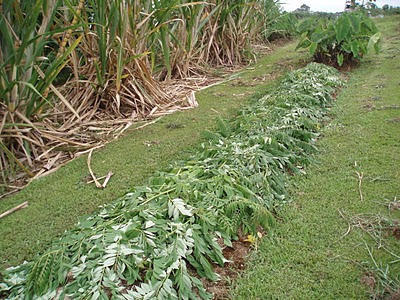
Chop 'n drop
Chop 'n drop is a catchy
permaculture term for cutting plants and
letting them lie on the soil surface around fruit trees as a homegrown,
fungus-promoting mulch. When choosing mulch-producing plants, you
want to be sure to select species that can regrow multiple times in a
year (among woody plants, look for trees that can be coppiced), and
you'll also want to look at the quality of the biomass produced.
Any organic matter is
good, but if you want to replace compost with
chop 'n drop plants, head for the nitrogen-fixing legumes. On the
other hand, if you want to build soil as fast as possible, look instead
for less succulent plants like grains and trees. Another factor
to consider is dynamic
accumulation --- if
your soil is deficient in a particular
nutrient, these plants can often pull lost nutrients up from below the
root zone and make it available again.
Finally, don't forget
that your chop 'n drop plants will be competing
with any useful plants they intermingle roots with. In poor soil
like ours, it's best to keep the mulch producers outside the dripline
of fruit trees, which means your chop 'n drop technique will probably
look more like chop 'n toss-a-few-feet-to-the-side. Some plants
(like comfrey) are notorious for being impossible to eradicate once
they're in place, so if you don't want them to compete with your adult
trees, plant them beyond th eventual dripline.
 I'm thinking of adding some
chop 'n drop shrubs in the gaps between the
eventual canopy spread of my fruit trees in the forest
garden, with comfrey
lining the paths. Elderberry, mulberry,
hazel, and willow are all trees that coppice well (and which I can
propagate from existing plants in my garden or surrounding
areas). Pampas grass might be worth a try too --- the plants look
like they produce masses of quality organic matter every year, although
I'm not sure whether you can cut them in such a way that you don't end
up with seeds in your mulch. Finally, I haven't decided if I want
to mess with nitrogen-fixers yet since soil rebuilding is currently my
top priority, but if I do branch out, top choices there include
Siberian pea shrub and alder.
I'm thinking of adding some
chop 'n drop shrubs in the gaps between the
eventual canopy spread of my fruit trees in the forest
garden, with comfrey
lining the paths. Elderberry, mulberry,
hazel, and willow are all trees that coppice well (and which I can
propagate from existing plants in my garden or surrounding
areas). Pampas grass might be worth a try too --- the plants look
like they produce masses of quality organic matter every year, although
I'm not sure whether you can cut them in such a way that you don't end
up with seeds in your mulch. Finally, I haven't decided if I want
to mess with nitrogen-fixers yet since soil rebuilding is currently my
top priority, but if I do branch out, top choices there include
Siberian pea shrub and alder.
I'd love to hear which
chop 'n drop plants you've used and why they
were successful (or problematic) in your garden. Don't forget to
mention your general location in your comment so that folks will know
whether your recommendations are likely to suit their garden.
Want more in-depth information? Browse through our books.
Or explore more posts by date or by subject.
About us: Anna Hess and Mark Hamilton spent over a decade living self-sufficiently in the mountains of Virginia before moving north to start over from scratch in the foothills of Ohio. They've experimented with permaculture, no-till gardening, trailersteading, home-based microbusinesses and much more, writing about their adventures in both blogs and books.
Want to be notified when new comments are posted on this page? Click on the RSS button after you add a comment to subscribe to the comment feed, or simply check the box beside "email replies to me" while writing your comment.

While pampas grass does create a lot of biomass, you are also aware the the edges of the leaves are kind of "micro-serrated" in a way that if you brush past them carelessly they will slice you like a knife. I would think carefully about where I placed a plant like that.
The former owners of my little home in the city planted a pampas grass in the backyard. From photographic records that one plant had been there about four or five years, and took up a space about 12ft by 12ft. It took two work parties to remove it, and a winch to pull out most of the root ball. I then put the chicken yard over the top of where it had been, to make sure it did not come back...